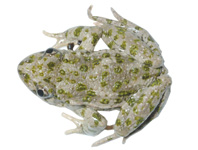Abstract
A new genus and species of damselfly, Burmagrion marjanmatoki, gen. et sp. nov., is described from Early Cretaceous Burmese amber. It is attributed to the basal stem group of Coenagrionoidea. The inclusion of five wings from the same species suggests that the amber piece contains the remains of a mating pair of damselflies.
References
Bechly, G. (1993) Fossil odonates in Dominican and Baltic amber. Argia, 5 (1), 13–15.
Bechly, G. (1996a) Morphologische Untersuchungen am Flügelgeäder der rezenten Libellen und deren Stammgruppenvertretern (Insecta; Pterygota; Odonata), unter besonderer Berücksichtigung der Phylogenetischen Systematik und des Grundbauplans der *Odonata. Petalura, (Spec. Vol.) 2, 1–402.
Bechly, G. (1996b) Fossil Odonates in Tertiary amber. Petalura, 2, 1–15.
Bechly, G. (1998a) New fossil damselflies from Baltic amber, with description of a new species, a redescription of Litheuphaea carpenter Fraser, and a discussion on the phylogeny of Epallagidae (Zygoptera: Caloptera). International Journal of Odonatology (Pantala), 1 (1), 33–63.
https://doi.org/10.1080/13887890.1998.9748092Bechly, G. (1998b) New fossil dragonflies from the Lower Cretaceous Crato Formation of north-east Brazil (Instecta: Odonata). Stuttgarter Beiträge zur Naturkunde, Serie B, 264, 1–66.
Bechly, G. (2000) A new fossil damselfly species (Insecta: Odonata: Zygoptera: Coenagrionidae: Ischnurinae) from Dominican Amber. Stuttgarter Beiträge zur Naturkunde, Serie B, 299, 1–9.
Bechly, G. (2003) Phylogenetic Systematics of Odonata. In: Schorr, M. & Lindeboom, M. (Eds.), Dragonfly Research 1.2003. Zerf-Tübingen (ISSN 1438 – 034x).
Bechly, G. (2007) Chapter 11.5 Odonata: damselflies and dragonflies. In: Martill, D.M., Bechly, G. & Loveridge, R.F. (Eds.), The Crato fossil beds of Brazil: window into an ancient world. Cambridge University Press, Cambridge, pp. 184–222.
Bechly, G. (2010) Further new fossil dragonflies from the Lower Cretaceous Crato Formation of Brazil (Insecta: Odonata). Paleodiversity, 3 (Suppl.), 11–17.
Bechly, G. (2012) An interesting new fossil relict damselfly (Odonata: Zygoptera: Coenagrionoidea) from Eocene Baltic amber. Palaeodiversity, 5, 51–55.
Bechly, G. & Wichard, W. (2008) Damselfly and dragonfly nymphs in Eocene Baltic amber (Insecta: Odonata), with aspects of their palaeobiology. Palaeodiversity, 1, 37–47.
Cruickshank, R.D. & Ko, K. (2003) Geology of an amber locality in the Hukaung Valley, northern Myanmar. Journal of Asian Earth Sciences, 21, 441–455.
https://doi.org/10.1016/S1367-9120(02)00044-5Dijkstra, KD.B., Bechly, G., Bybee, S.M., Dow, R.A., Dumont, H.J., Fleck, G., Garrison, R.W., Hämäläinen, M, Kalkman, V.J., Karube H., May, M.L., Orr, A.G., Paulson, D.R., Rehn, A.C., Theischinger G., Trueman, J.W.H., van Tol, J., von Ellenrieder, N. & Ware, J.L. (2013) The classification and diversity of dragonflies and damselflies (Odonata). In: Zhang, Z.-Q.(Ed.), Animal Biodiversity: An Outline of Higher-level Classification and Survey of Taxonomic Richness (Addenda 2013). Zootaxa, 3703 (1), 36–45.
http://dx.doi.org/10.11646/zootaxa.3703.1.9Dutta, S., Mallick, M., Kumar, K., Mann, U. & Greewood, P.F. (2011) Terpenoid composition and botanical affinity of Cretaceous resins from India and Myanmar. International Journal of Coal Geology, 85, 49–55.
https://doi.org/10.1016/j.coal.2010.09.006Huang, D., Azar, D., Cai, C., Maksoud, S., Nel, A. & Bechly, G. (2017) Mesomegaloprepidae, a remarkable new damselfly family (Hexapoda: Odonata: Zygoptera) from mid-Cretaceous Burmese amber. Cretaceous Research, 73, 1–13.
https://doi.org/10.1016/j.cretres.2015.05.004Jarzembowski, E.A., Martínez-Delclós, X., Bechly, G., Nel, A. Coram, R. & Escuillié, F. (1998) The Mesozoic non-calopterygoid Zygoptera: description of new genera and species from the Lower Cretaceous of England and Brazil and their phylogenetic significance (Odonata, Zygoptera, Coenagrionoidea, Hemiphlebioidea, Lestoidea). Cretaceous Research, 19, 403–444.
https://doi.org/10.1006/cres.1997.0113Nel, A., Didier, N., Perrichot, V., Girard, V. & Gomez, B. (2008) A new dragonfly family from the Upper Cretaceous of France. Acta Paleontologica Polonica, 53, 165–168.
https://doi.org/10.4202/app.2008.0113Nel, A., Martínez-Delclòs, X., Paichler, J.C. & Henrotay, M. (1993) Les ‘Anisozygptera’ fossiles. Phylogénie et classification (Odonata). Martinia, Numéro Hors Série 3, 1–311.
Poinar, G. Jr., Bechly, G. & Buckley, R. (2010) First record of Odonata and a new subfamily of damselflies from early Cretaceous Burmese amber. Paleodiversity, 3, 15–22.
Poinar, G.O. Jr., Lambert, J.B. & Wu, Y. (2007) Araucarian source of fossiliferous Burmese amber: spectroscopic and anatomical evidence. Journal of the Botanical Research Institute of Texas, 1, 449–455.
Riek. E.F. & Kukalová-Peck, J. (1984) A new interpretation of dragonfly wing venation based upon early Upper Carboniferous fossils from Argentina (Insects: Odonatoidea) and basic character states in pterygote wings. Canadian Journal of Zoology, 62, 1150–1166.
https://doi.org/10.1139/z84-166Shi, G., Grimaldi, D.A., Harlow, G.E., Wang, J., Wang, J., Yang, M., Lei, W., Li, Q. & Li, X. (2012) Age constraint on Burmese amber based on U–Pb dating of zircons. Cretaceous Research, 37, 155–163.
https://doi.org/10.1016/j.cretres.2012.03.014Zheng, D., Zhang, Q., Chang, S.-C. & Wang, B. (2016a) A new damselfly (Odonata: Zygoptera: Platystictidae) from mid-Cretaceous Burmese amber. Cretaceous Research, 63, 142–147.
https://doi.org/10.1016/j.cretres.2016.03.006Zheng, D. Wang, B., Jarzembowski, E.A., Chang, S.-C. & Nel, A. (2016b) The first fossil Perilestidae (Odonata: Zygoptera) from mid-Cretaceous Burmese amber. Cretaceous Research, 65, 199–205.
Zheng, D., Zhang, Q., Nel, A., Jarzembowski, E.A., Zhou, Z., Chang, S.-C. & Wang, B. (2016c) New damselflies (Odonata: Zygoptera: Hemiphlebiidae, Dysagrionidae) from mid-Cretaceous Burmese amber. Alcheringa.
https://doi.org/10.1016/j.cretres.2016.05.002Zheng, D., Wang, B., Chang, S.-C. & Nel, A. (2016d) Burmadysagrioninae, a new subfamily (Odonata: Zygoptera: Dysagrionidae) from mid-Cretaceous Burmese amber. Cretaceous Research.
https://doi.org/10.1016/j.cretres.2016.07.006

